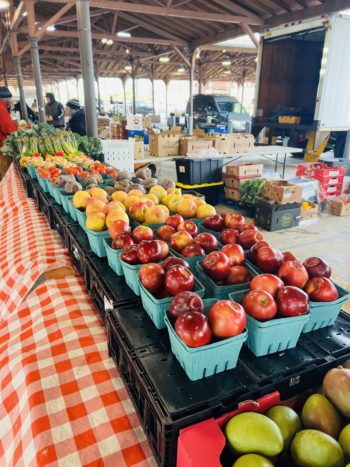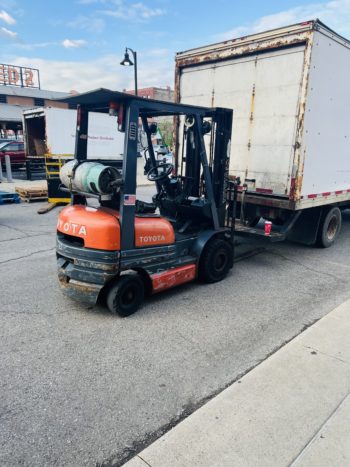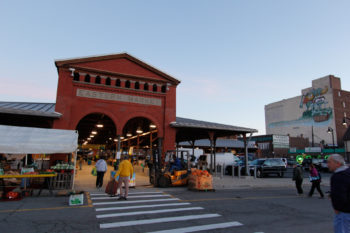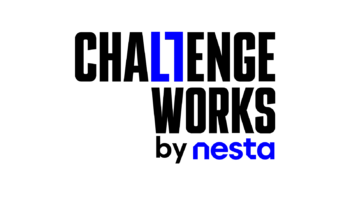What we learned in designing the Detroit ‘Transforming Freight’ Challenge
11 July 2024
Everyone knows something about Detroit. You might think of the auto industry and the industrial heritage. Or maybe you think of Motown or Eminem. Or, more recently, the municipal bankruptcy, or the story of the hollowing out (and subsequent resurgence) of America’s cities. If you’re into urban regeneration, maybe your mind goes to Dan Gilbert and Quicken Loans, or the historic rebirth of Michigan Central Station anchoring the new innovation district.
All these things were on my mind as our team of researchers and designers from Challenge Works visited the city in March, along with our partners from Toyota Mobility Foundation and World Resources Institute, under the umbrella of the Sustainable Cities Challenge. We were there to kick off a four-month design sprint with Detroit to better understand and define the problem to be solved and the opportunity for innovation.
Our goal for the week was to create a tightly defined open innovation challenge centred around decarbonising freight operations in the city’s Eastern Market. To get there, we had to get under the skin of the city, the people, the systems underlying how Eastern Market and the surrounding neighbourhood work, and the ripple effects that solving the challenge could have – intended and unintended.
This thinking began back in November, when Detroit was one of 10 shortlisted cities that participated in our capacity building programme to upskill city leaders on problem identification and challenge definition and design. We started work with the team from Detroit then to explore freight operations in Eastern Market and different levers that could be pulled to decarbonise the sector, and by February, Detroit had been selected as one of the three partner cities so we could begin work in earnest.

Going deep on freight in Eastern Market
Upon landing in Detroit on an unseasonably warm day in early March, we first went straight to Eastern Market itself, located about a mile northeast of downtown. At 43 acres, it is the largest historic public market district in the country, and has operated at this site since the late 19th century. The market’s centrepiece is a six-block public market, open to the public on Saturdays year-round and extra days in the summer, but our focus is on the market’s wholesale activities. Eastern Market is Detroit’s hub for food production, processing, packaging, and distribution, selling over $360 million of wholesale food, and exporting almost twice as much to international markets. Eastern Market Corporation, the non-profit that runs the market, organises farmers, wholesalers, logistics operators, and distributors to move food that feeds millions, with distribution networks that extend across Michigan, the Upper Midwest, and nationally.
So we learned a story of regional food systems, of farmers and producers, of small businesses coming to the market to trade and businesses based in the district, who rely on intricate webs of trusted relationships, deeply ingrained patterns and routines, and a dedication to hard work, early mornings, and high-quality products.
Early on a Tuesday morning, we watched the tail end of overnight operations as the sun rose over eastern Detroit, hearing from farmers about their history of growing and selling food and protecting their land and workers across generations. We visited local businesses, seeing, for example, the daily operations of butchers that provide halal meats for Michigan’s large Muslim population.
We heard about the choreography of freight logistics, the large and small trucks that pull in and out of the market daily, how long they idle for, how fleet managers plan and track movement, how cold chain storage works, and more, all of which affect energy use, emissions, efficiency, and bottom lines.

Situating the challenge in Eastern Market within the city’s future vision
From city planners and state officials and leaders like Dan Carmody at Eastern Market Corporation we also learned about the vision for the district’s future, which involves more space for the wholesalers, and for makers and small businesses to get a foothold, as well as more homes in the surrounding neighbourhood. We heard about aspirations to create a better future for the children who live and go to school nearby. For example, a major highway, I-375, runs adjacent to the market. A segment of this interstate will be converted into a boulevard-style road in the next few years, creating better pedestrian connectivity and freeing up land for redevelopment, while also rerouting freight travel to and from the market.
Taking in all these dimensions of what Eastern Market means to the community, we sharpened focus on the specific problem at hand: how could an innovation challenge reduce emissions associated with the market’s freight operations while creating a better future for all of the stakeholders involved?
This coalesced around two goals:
- To support a more resilient food system, and sustain the growers and producers – as well as the customers – who rely on the market, we need to boost the efficiency of market operations.
- At the same time, to enable the market to expand, and create more opportunities for businesses within and beyond the market in eastern Detroit, while promoting a healthier environment for the people who work and live in and around the market, we need to decarbonise the systems that will make that growth possible.

The collaborative design process
Coming back to our goal for the week: we needed to identify the innovation gap and the opportunity for innovators, map out the challenge structure, determine the impact goals, and create the criteria for success. And it is far better to do this through a collaborative, evidence-driven approach – we know we’ll get better solutions in the end if we engage the people and institutions affected from the start, rather than just decide all of the design ourselves.
Taking this all in, we mapped out:
- The problem space: how to cut emissions while improving efficiencies?
- The opportunity for innovation: this would include tech, but also the innovation gaps in service design and product adoption.
- The barriers to innovation and what has been tried already: this is about costs, but also operation standards, expectations of the buyers and sellers, cultural norms, and traditions.
- The stakeholders: who are the beneficiaries of solving these problems? Who are the customers that would buy or sustain solutions? Who will use the solutions? Who are the enablers, or the blockers? And who would create the solutions?
We ran a series of exercises with our partners at the city and the market, as well as local experts working in tech and mobility, to answer these questions.
For starters, we created nine potential challenge statements, all focused on different dimensions of the problem and the points of innovation, and stress-tested each of them to examine their suitability to solving through open innovation, their potential impact, and feasibility given the time and budget. We considered various linchpins to solve the problem: is it data? Is it cold-chain storage? Idling time? Fuel?
We also explored the existing tech infrastructure and what innovators would need to help develop solutions and test prototypes. For example, what data already exists and what can easily be obtained, and how? How could we work with local partners to do product testing – virtually, in a testing facility, and in the market itself?
Based on the working challenge statement, we then mapped out the judging criteria, by brainstorming the information that we would need from innovators so that the judges could compare and choose the best solutions for developing, testing, and ultimately implementation. We categorised these into performance measures (does it work?), relevance (will it be used?), innovation (what does it offer that is new?), capability (can this team do it?), impact (does it help solve the problem?) and viability (will it last?).
And finally, we mapped out the challenge structure. This includes not just the timeline and syncing that timeline with the growing seasons and peaks and troughs of market activity, but also the stage-gates, the number of innovators we can support, and the types of incentives and support they would need, in both funding but also connections, testing, and capacity building.
We experimented with different variations of these factors, and tested our ideas with the market and the city, to calibrate the challenge activities to the market and the operators’ capacity, based on a set of emerging guiding principles:
- Balance co-design and demonstration with real-world operations: solutions created as part of the challenge need to be relevant and co-designed with operators and Eastern Market – and we need to minimise disruption of day-to-day market operations.
- Look at all the angles: anticipate and mitigate negative unintended consequences of potential solutions to the market and the community
- Create enduring solutions: prioritise solutions that feature interoperability and transparency so solutions can serve the market in the long-term.
After our time on the ground in the city ended, we continued to iterate and refine the challenge design and theory of change, debating the details and modelling different scenarios, with our partners in the city and with industry experts and potential challenge entrants, until we felt confident and ready to launch in May.
What’s next?
The Detroit Challenge is now closed for entries . To accelerate innovation that will enhance operational efficiency while creating a lower-carbon future in and around Eastern Market, we are looking for innovators to enter with solutions that will reduce fossil fuel use and cut costs of freight operations. Selected entrants will receive funding but also crucially, the chance to work with the city and the companies in Eastern Market to bring their solutions to reality. To learn more, visit the challenge website at Sustainable Cities Challenge.
Special thanks to all of the experts and local leaders who generously gave their time to this effort, including Vince Keenan and Tim Slusser at the City of Detroit Office of Mobility Innovation; Dan Carmody, Katy Trudeau and Brandon Seng at Eastern Market Partnership; Rob Ruelig and Saad Meats; Kevin Mull at the Urban Tech Exchange; the many business owners within the market; and to John Daly at Toyota Mobility Foundation and Teodora Chis and Piotr Gierszweski with Challenge Works for their tireless efforts in research and design.
You might also like…
-
![overhead photo of rows of parking lorries]()
Detroit City Challenge
We are looking for innovators to demonstrate solutions that decrease fossil fuel use and reduce costs of freight operations in Detroit’s Eastern Market.
-
![A road with several vehicles]()
The Sustainable Cities Challenge
The Sustainable Cities Challenge aims to harness the power, creativity and energy of innovation to improve access to safe, equitable and sustainable mobility solutions for all. Through two stages, the global Sustainable Cities Challenge will award $9 million to improve mobility solutions in cities around the world.


